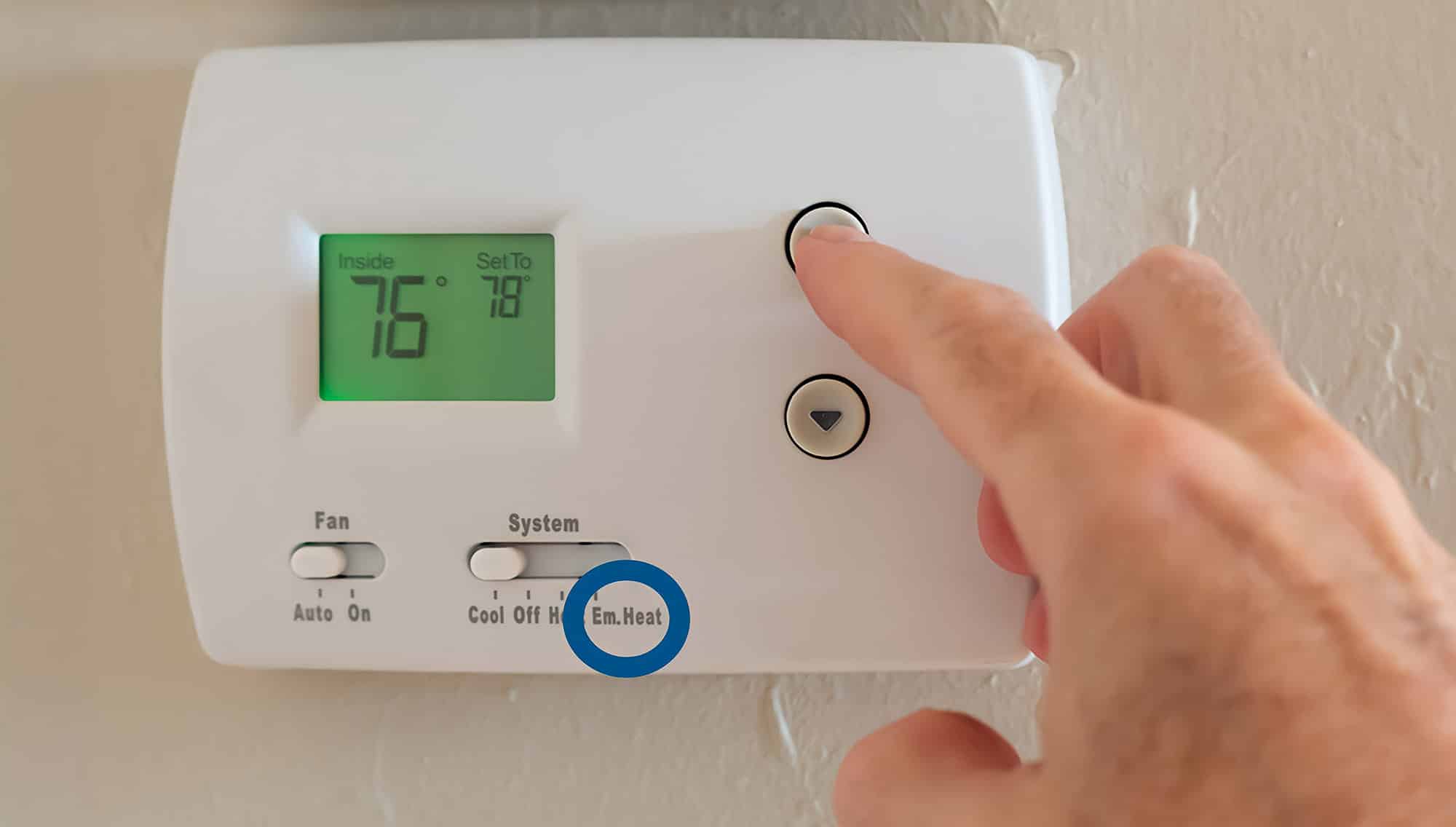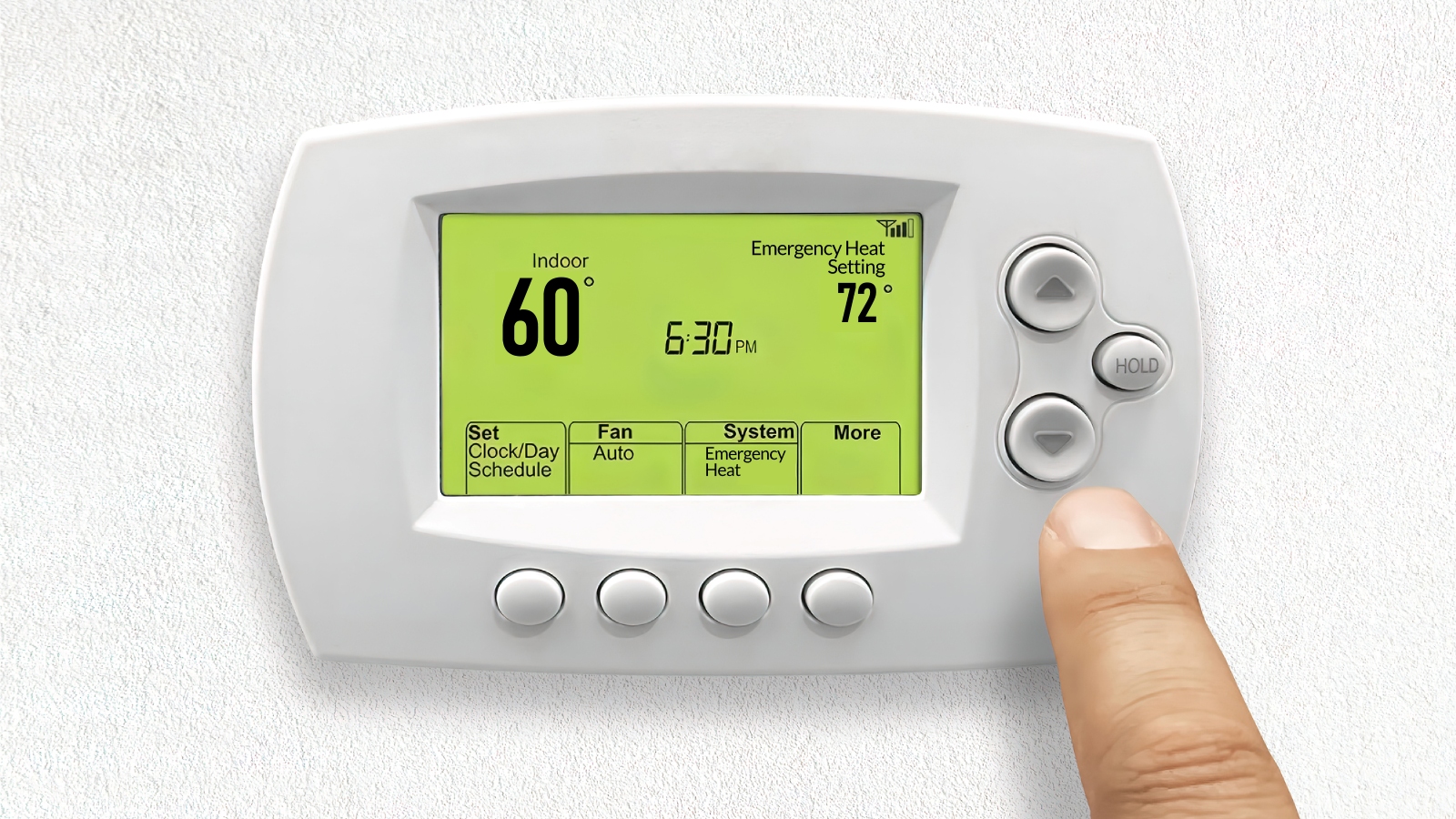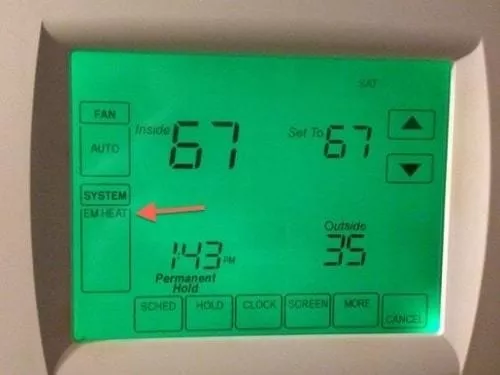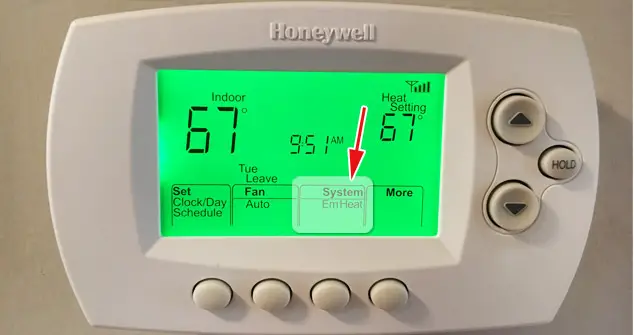Check Best Thermostat Pricing in Amazon
** As an Amazon Associate, I earn from qualifying purchases.
Em Heat, short for Emergency Heat, is a setting on some thermostats. It activates the backup heating system during cold weather.
Understanding Em Heat is crucial for homeowners, especially during winter. This thermostat setting is usually found in homes with heat pumps. Heat pumps are efficient, but sometimes they need help in extremely cold conditions. Em Heat steps in when the primary heat source cannot keep up.
It uses a different heating method to ensure your home stays warm. Knowing how and when to use Em Heat can save you from uncomfortable chilly days and ensure your heating system runs efficiently. Let’s explore what Em Heat is, how it works, and when to use it.
Introduction To Emergency Heat
Ever wondered what that “Em Heat” setting on your thermostat actually does? You’re not alone. Emergency Heat, often abbreviated as “Em Heat,” is a crucial feature in many heating systems, especially heat pumps. It’s designed to keep you warm when your primary heating system fails. Understanding how and when to use it can save you from freezing during unexpected cold snaps.
Purpose Of Emergency Heat
Emergency Heat is a backup heating option. It kicks in when your main heating system, typically a heat pump, isn’t working properly. Heat pumps are great for energy efficiency, but they can struggle in extremely cold temperatures.
That’s where Emergency Heat comes in. It’s like having a spare tire in your car. You hope you never need it, but it’s a lifesaver when you do. Emergency Heat uses electric or gas resistance heating to warm your home. This method is less efficient but reliable in emergencies.
When To Use Emergency Heat
You should use Emergency Heat only in specific situations. One key scenario is when your heat pump is malfunctioning. If you notice your home isn’t getting warm even though the thermostat is set correctly, it might be time to switch to Emergency Heat.
Another instance is during extreme cold weather. Heat pumps are less effective at very low temperatures, sometimes below 30°F. If your heat pump struggles to maintain a comfortable temperature, Emergency Heat can provide the necessary warmth.
Always consult your HVAC technician if you’re unsure. Misusing Emergency Heat can lead to higher energy bills. It’s best to use it as a temporary measure while waiting for professional help.
Have you ever had to use Emergency Heat? How did it affect your heating bill? Share your experiences in the comments below!
How Emergency Heat Works
Emergency heat, or Em Heat, is a feature on many thermostats. It provides a backup heating source for your home. This system kicks in during extreme cold or if the primary heat source fails. But how does this emergency heat work? Let’s dive into the components involved and the activation process.
Components Involved
The emergency heat system includes several components. The heat pump is the primary unit. It usually handles the heating. A secondary heating source, often electric resistance coils, serves as the backup. The thermostat controls both systems. It activates the emergency heat when needed. Each part plays a crucial role in maintaining your home’s warmth.
Activation Process
The activation process is straightforward. The thermostat detects the indoor temperature. If the primary heat source can’t maintain the set temperature, the emergency heat activates. It may also activate if the heat pump fails. The thermostat switches to the backup heating system. This ensures your home stays warm even during extreme cold.
You can also manually activate the emergency heat. This is useful if you suspect a problem with the heat pump. Switching to Em Heat ensures continued warmth while you address the issue. The process is simple. Set your thermostat to emergency heat mode. The backup system will take over.
Understanding how emergency heat works helps you manage your home’s heating. It ensures you stay warm during unexpected situations.
Differences Between Emergency Heat And Regular Heating
Understanding the differences between emergency heat and regular heating can save you a lot of headaches during the cold seasons. While both systems aim to keep your home warm, they function in distinct ways and have different implications for your energy bill. Let’s dive into these differences to help you make informed decisions.
Functionality Comparison
Regular heating typically uses your heat pump to warm your home. It works by extracting heat from outside air and transferring it inside. This method is quite efficient, especially in moderate cold.
Emergency heat, on the other hand, is a backup system. It kicks in when the heat pump can’t keep up with extremely cold temperatures. Instead of using outside air, it relies on electric resistance heating, which can be less efficient but essential in freezing conditions.
Energy Efficiency
Regular heating is generally more energy-efficient. Since it uses the existing heat in the air, it requires less electricity to maintain a comfortable temperature. This keeps your energy bills lower.
Emergency heat, however, consumes significantly more electricity. It uses electric resistance heating, which can quickly drive up your utility costs. While it’s a lifesaver in a pinch, using it for extended periods can be expensive.
Have you noticed a spike in your energy bill during the winter? It might be worth checking if your system is running on emergency heat more often than necessary. This small adjustment can lead to significant savings.
Now that you know the key differences, how will you manage your heating system this winter? Understanding these functionalities and their impact on energy efficiency can help you make smarter choices and keep your home cozy without breaking the bank.
Pros And Cons Of Emergency Heat
Emergency heat, often called Em Heat, is a backup heating option. It activates when your heat pump fails or cannot keep up. This system has its own set of advantages and disadvantages.
Advantages
Emergency heat provides instant warmth. This is crucial during extreme cold. It ensures your home stays comfortable. It also prevents pipes from freezing. This can save you from costly repairs. Em Heat is reliable. It works even if the main heat pump fails. This reliability offers peace of mind.
Disadvantages
Emergency heat uses more energy. This leads to higher utility bills. It is less efficient than a heat pump. Em Heat should not be used for long periods. Running it continuously can be costly. It is meant for temporary use only. Using it often can wear out the system faster. This can lead to more frequent repairs.
Common Misconceptions
Many homeowners often misunderstand the emergency heat (Em Heat) setting on their thermostats. These misunderstandings can lead to improper use and higher energy bills. Let’s clear up some of the common misconceptions about Em Heat.
Myths About Emergency Heat
Some believe that Em Heat is a faster way to heat their home. This is not true. Em Heat uses more energy and is less efficient. It should only be used in specific situations.
Another myth is that Em Heat is the same as regular heat. They are different. Em Heat bypasses the heat pump and uses electric resistance heating. This can be very costly.
Clarifying Misunderstandings
Em Heat is for emergencies. If your heat pump fails, use Em Heat. It is not for everyday use. Only use it when necessary.
Check Best Thermostat Pricing in Amazon
** As an Amazon Associate, I earn from qualifying purchases.
Some think Em Heat is better for extremely cold days. This is incorrect. Your regular heat pump is designed to handle cold temperatures. Em Heat should be a last resort.

Credit: www.watkinsheating.com
Troubleshooting Emergency Heat Issues
Troubleshooting emergency heat issues can be daunting, especially during the coldest months. Understanding what might be going wrong and how to fix it can save you a lot of trouble. Here’s a guide to help you navigate these problems with ease.
Signs Of Problems
Recognizing the signs of emergency heat issues is crucial. If your home isn’t warming up, that’s a red flag. Another sign is if your thermostat’s emergency heat setting is constantly on.
You might also notice unusual noises from your heating system. Sudden spikes in your energy bill can also indicate a problem. Pay attention to these signs before they become bigger issues.
Steps To Resolve
First, check your thermostat settings. Ensure it is set to ‘heat’ and not just ’em heat’. Sometimes, a simple adjustment can resolve the issue.
If that doesn’t work, inspect your air filters. Dirty or clogged filters can impede airflow, making your system work harder than necessary.
Next, take a look at your circuit breakers. A tripped breaker can cut power to your heating system. Reset any tripped breakers and see if that resolves the problem.
If none of these steps work, it might be time to call a professional. A heating specialist can diagnose and fix more complex issues. Have you ever faced an emergency heat problem? How did you solve it? Share your experience in the comments!
Maintenance Tips
Maintaining the Em Heat setting on your thermostat ensures efficient heating during emergencies. Regular maintenance can help prolong the lifespan of your heating system. This section provides simple tips to keep your Em Heat in top condition.
Regular Checks
Perform regular checks on your thermostat and heating system. Look for any signs of wear or damage. Check the thermostat settings to ensure they are correct. Replace batteries if needed. Ensure the Em Heat function works properly. Regular checks help identify issues early.
Professional Servicing
Schedule professional servicing for your heating system. A professional can thoroughly inspect your system. They can identify potential problems and fix them. Servicing should be done annually. This ensures your Em Heat function remains reliable. Professional servicing can prevent costly repairs.

Credit: charlottecomfortsystems.com
Choosing The Right Thermostat
Choosing the right thermostat for your home can be overwhelming. With so many options available, it’s essential to find a thermostat that fits your needs, especially when it comes to managing emergency heat (Em Heat). Let’s dive into the key features and compatibility factors to consider.
Features To Look For
When selecting a thermostat, prioritize the features that will make your life easier. Look for programmable options that allow you to set schedules. This can help save energy and reduce your bills.
Consider Wi-Fi enabled thermostats. These can be controlled remotely via a smartphone app, offering convenience and flexibility. Smart thermostats can even learn your preferences over time and adjust settings automatically.
Ensure the thermostat has an easy-to-read display and user-friendly interface. You don’t want to struggle with complicated settings when you need to adjust the temperature quickly. A clear display can make a big difference.
Compatibility With Emergency Heat
Not all thermostats are compatible with emergency heat systems. Check if the thermostat supports a heat pump with auxiliary heating. This is crucial for maintaining comfort during extreme cold weather.
Read the specifications and consult with the manufacturer if necessary. Ensure the thermostat can seamlessly switch to emergency heat when needed. This can prevent any disruptions in your heating system.
Some advanced models offer alerts and notifications. These can inform you if there is an issue with the emergency heat. Staying informed can help you address problems before they become serious.
Choosing the right thermostat is vital for efficient and reliable home heating. Have you considered all the essential features and compatibility factors for your thermostat? It’s worth the effort to find the perfect match for your needs.

Credit: jonwayne.com
Frequently Asked Questions
Should My Thermostat Be On Heat Or Em Heat?
Set your thermostat to “heat” for regular heating. Use “em heat” only if your heat pump malfunctions.
Is It Okay To Run Emergency Heat?
Yes, it’s okay to run emergency heat. Use it during extreme cold or if your main heating fails.
Is Emergency Heat More Expensive?
Yes, emergency heat is usually more expensive. It uses electric resistance heating, which costs more than standard heating methods.
Why Did My Heat Switch To Emergency Heat?
Your heat switched to emergency heat due to a malfunction in the main heating system or extremely low outdoor temperatures.
Conclusion
Em Heat on a thermostat is crucial for cold climates. It provides extra heat during freezing temperatures. Understanding its use can ensure comfort. Proper usage can also save energy. Always check your thermostat settings. Keep your home cozy and efficient.
Em Heat is a vital feature for winter months. Knowing how it works helps manage your heating system better. Stay warm and reduce heating costs. Remember to maintain your thermostat regularly. This ensures optimal performance. Enjoy a comfortable home year-round.
Check Best Thermostat Pricing in Amazon
** As an Amazon Associate, I earn from qualifying purchases.


